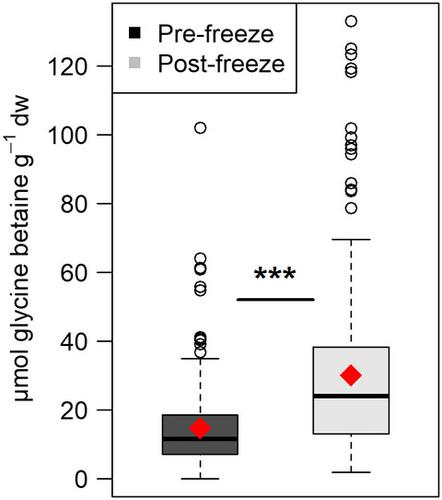Our official English website, www.x-mol.net, welcomes your feedback! (Note: you will need to create a separate account there.)
The role of glycine betaine in range expansions; protecting mangroves against extreme freeze events
Journal of Ecology ( IF 5.5 ) Pub Date : 2019-07-18 , DOI: 10.1111/1365-2745.13243 Matthew A. Hayes 1, 2 , Audrey C. Shor 3 , Amber Jesse 2 , Christopher Miller 3 , John P. Kennedy 4 , Ilka Feller 2
中文翻译:

甘氨酸甜菜碱在范围扩展中的作用;保护红树林免受极端冰冻事件的影响
更新日期:2019-07-18
Journal of Ecology ( IF 5.5 ) Pub Date : 2019-07-18 , DOI: 10.1111/1365-2745.13243 Matthew A. Hayes 1, 2 , Audrey C. Shor 3 , Amber Jesse 2 , Christopher Miller 3 , John P. Kennedy 4 , Ilka Feller 2
Affiliation

|
- Due to a warming climate, mangrove populations within the Gulf of Mexico and along the Florida Atlantic coastline are expanding their range poleward. As mangroves expand their range limit, leading edge individuals are more likely to experience an increased incidence of freeze events. However, we still lack a clear understanding of the mechanisms used by mangroves to survive freezing conditions.
- Here, we conducted common garden experiments at different locations experiencing variable winter freeze conditions to show glycine betaine, an organic osmolyte, increases significantly with freeze exposure, playing an important role in the freeze tolerance of Avicennia germinans, a widespread Neotropical mangrove.
- We found glycine betaine accumulation was similar across all source populations and freeze exposure locations, suggesting glycine betaine is not a range limit adaptation and is instead used for freeze tolerance by A. germinans irrespective of source population. Plants sourced from populations that experience freezing conditions exhibited greater rates of survival, indicating range edge populations of A. germinans have other heritable adaptations in addition to glycine betaine for freeze tolerance.
- Synthesis. Continued mangrove expansion poleward will result in a greater incidence of freeze events for individuals at the leading edge. Our findings suggest freeze tolerance in this species may be genetically based and that leading edge A. germinans have the potential to survive extreme freeze events and recover post‐freeze, allowing for their continued expansion poleward. This process of selective survival may act to promote adaptation of freeze tolerance in range edge populations.
中文翻译:

甘氨酸甜菜碱在范围扩展中的作用;保护红树林免受极端冰冻事件的影响
- 由于气候变暖,墨西哥湾内和佛罗里达大西洋沿岸的红树林种群向极地扩展。随着红树林范围的扩大,前沿个人更有可能遇到更多的冻结事件。但是,我们仍然对红树林在冰冻条件下生存的机制缺乏清晰的了解。
- 在这里,我们在不同的地点经历了不同的冬季冻结条件的地方进行了常见的花园实验,结果显示,甘氨酸甜菜碱(一种有机渗透物)随着冻结暴露量的增加而显着增加,这在广泛分布的新热带红树林Avicennia germinans的冻结耐受性中发挥了重要作用。
- 我们发现,甘氨酸甜菜碱在所有来源种群和冷冻暴露位置上的积累都是相似的,这表明甘氨酸甜菜碱不是范围限制适应性的,而是被A.germinans用作冷冻耐受性,与来源种群无关。来自经历冷冻条件的种群的植物表现出更高的存活率,表明A.germinans的范围边缘种群除甘氨酸甜菜碱以外还具有其他可遗传的适应性,以用于冷冻耐受。
- 综合。红树林不断向极地扩展将导致前沿地区个体发生冻结事件的可能性增加。我们的发现表明,该物种的耐冻性可能是基于遗传的,并且前沿的A.germinans有可能在极端的冷冻事件中幸存并在冷冻后恢复,从而使其继续极速扩张。这种选择性存活的过程可能起到促进适应范围边缘种群的耐冻性的作用。



























 京公网安备 11010802027423号
京公网安备 11010802027423号